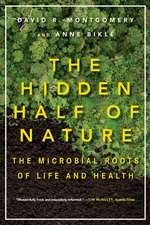Cyanotoxins: Occurrence, Causes, Consequences
Editat de Ingrid Chorusen Limba Engleză Paperback – 18 sep 2011
Preț: 644.63 lei
Preț vechi: 758.38 lei
-15% Nou
Puncte Express: 967
Preț estimativ în valută:
123.35€ • 129.05$ • 102.47£
123.35€ • 129.05$ • 102.47£
Carte tipărită la comandă
Livrare economică 03-17 aprilie
Preluare comenzi: 021 569.72.76
Specificații
ISBN-13: 9783642640049
ISBN-10: 3642640044
Pagini: 380
Ilustrații: XVIII, 357 p.
Dimensiuni: 155 x 235 x 20 mm
Greutate: 0.54 kg
Ediția:Softcover reprint of the original 1st ed. 2001
Editura: Springer Berlin, Heidelberg
Colecția Springer
Locul publicării:Berlin, Heidelberg, Germany
ISBN-10: 3642640044
Pagini: 380
Ilustrații: XVIII, 357 p.
Dimensiuni: 155 x 235 x 20 mm
Greutate: 0.54 kg
Ediția:Softcover reprint of the original 1st ed. 2001
Editura: Springer Berlin, Heidelberg
Colecția Springer
Locul publicării:Berlin, Heidelberg, Germany
Public țintă
ResearchCuprins
1 Introduction: Cyanotoxins — Research for Environmental Safety and Human Health.- 2 Cyanotoxin Occurrence in Freshwaters.- 2.1 Cyanotoxin Occurrence in Germany.- 2.2 Comparison of Cyanotoxin Occurrence in Different Countries.- 2.3 Release and Persistence of Microcystins in Natural Waters.- 3 Factors Controlling Cellular Microcystin Content.- 3.1 Effects of Light and Nutrient Supply on Growth and Microcystin Content of Different Strains of Microcystis aeruginosa.- 3.2 Light-Limited Growth and Microcystin Content of Planktothrix agardhii and Microcystis aeruginosa in Turbidostats.- 3.3 Importance of Energy Charge for Microcystin Production.- 3.4 Characterization of Microcystin Synthetase Genes in Microcystis aeruginosa.- 4 Factors Affecting Cyanotoxin Concentrations in Natural Populations.- 4.1 Microcystin Variants in Microcystis and Planktothrix Dominated Field Samples.- 4.2 Isolation and Characterization of Colony-Forming Microcystis aeruginosa Strains.- 4.3 Environmental Factors an Microcystin Levels in Waterbodies.- 5 Cyanobacterial Toxicity and Human Exposure.- 5.1 Cyanotoxins and Human Health — Overview.- 5.2 Recreational Exposure to Cyanotoxins.- 5.3 Cyanotoxins in Drinking-Water Supplies.- 6 Effects of Microcystis spp. and Selected Cyanotoxins on Freshwater Organisms.- 6.1 Effects of Cyanotoxins on Early Life Stages of Fish and Amphibians.- 6.2 Uptake, Enzyme Effects and Metabolism of Microcystin-LR in Aquatic Organisms.- 6.3 Changes of Fish Behaviour Affected by Microcystin-LR.- 6.4 Responses of Daphnia galeata fed with Microcystis strains with and without Microcystins.- 7 Toxic Effects and Substances in Cyanobacteria other than Microcystins, Anatoxin-a and Saxitoxins.- 7.1 Peptides and Depsipeptides Produced by Cyanobacteria.- 7.2 Significance ofUnidentified Toxic Compounds and Approaches to their Identification.- 7.3 New Cyanobacterial Substances with Bioactive Properties.- 8 Contributions to Toxicity Testing and Toxin Analysis.- 8.1 Testing Cyanobacterial Toxicity with Primary Rat Hepatocyte and Cell-Line Assays.- 8.2 Can the Primary Rat Hepatocyte Assay Replace the Mouse Assay for Microcystin Testing? Validation with “Historic” Samples from the First Survey on Cyanobacterial Toxicity in Germany.- 8.3 Comparative Evaluation of Methods for Assessing Microcystin Concentrations with a Variety of Field Samples.- 8.4 A Fish-Embryo Bioassay for the Assessment of Cyanobacterial Toxicity.- 8.5 Rapid Typing and Structure Determination of Cyanobacterial Peptides Using MALDI-TOF Mass Spectrometry.- 9 Routine Analytical Methods Applied in the German Cyanotox Project.- 9.1 Microcystin Analysis.- 9.2 Cell Counting, Determination of Biovolume and Chlorophyll-a.
Textul de pe ultima copertă
Toxic cyanobacteria are increasingly recognised as a potential hazard in water for human use. The recent availability of methods for quantitative screening is leading to a surge of research on their occurrence. This book presents a novel compilation of extensive screening results showing the cyanotoxin levels that may be expected when certain taxa dominate. These results indicate cyanotoxins to be the most widespread among the chemicals of concern in water used for drinking and recreation. It further combines field data with results from laboratory culture experiments to suggest a unifying view of how environmental factors control the cyanotoxin levels in natural waters. A practical section is dedicated to the exposure of humans through drinking-water and recreation.
Caracteristici
Results of a year-long research project initiated and supported by the BMBF and the WHO on toxins in water








